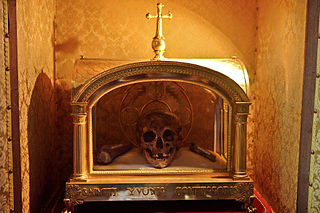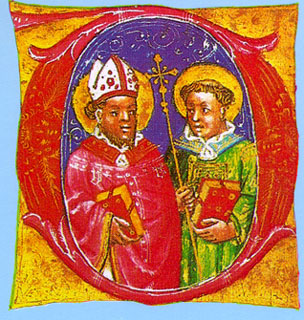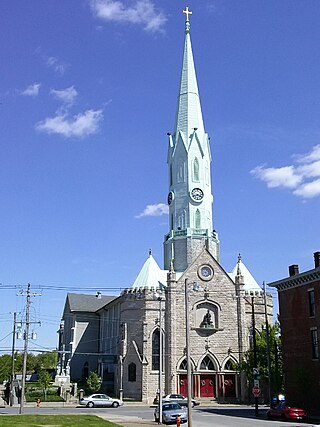
In religion, a relic is an object or article of religious significance from the past. It usually consists of the physical remains or personal effects of a saint or other person preserved for the purpose of veneration as a tangible memorial. Relics are an important aspect of some forms of Buddhism, Christianity, Islam, shamanism, and many other religions. Relic derives from the Latin reliquiae, meaning "remains", and a form of the Latin verb relinquere, to "leave behind, or abandon". A reliquary is a shrine that houses one or more religious relics.

August 18 - Eastern Orthodox liturgical calendar - August 20

Saint Geminianus was a fourth-century deacon who became Bishop of Modena. He is mentioned in the year 390, when he participated in a council called by Saint Ambrose in Milan. From his name, it has been deduced that Geminianus probably belonged to the caste of Roman senators.
Colle San Magno is a comune (municipality) in the Province of Frosinone in the Italian region Lazio, located about 110 kilometres (68 mi) southeast of Rome and about 30 kilometres (19 mi) southeast of Frosinone.

Pancras or Pancratius is an Italian saint associated with Taormina and venerated as a Christian martyr. His surviving hagiography is purely legendary. He is, however, recorded in some early martyrologies.

Ovidius, also Saint Auditus, was the third Bishop of Braga; he is a Portuguese saint.

SaintCaesarius of Terracina was a Christian martyr. The church of San Cesareo in Palatio in Rome bears his name.

Hermagoras of Aquileia is considered the first bishop of Aquileia, northern Italy. Christian tradition states that he was chosen by Mark to serve as the leader of the nascent Christian community in Aquileia, and that he was consecrated bishop by Peter. Hermagoras and his deacon Fortunatus evangelized the area but were eventually arrested by Sebastius, a representative of Nero. They were tortured and beheaded.
Theonistus is a saint venerated by the Catholic Church. Theonistus is venerated with two companions, Tabra and Tabratha. Medieval documents give accounts of his life, which are contradictory and confusing.

Chiaffredo is venerated as the patron saint of Saluzzo, Italy. Tradition considers him a member of the Theban Legion, but instead of being martyred with this legion at Agaunum, he escaped to Piedmont and was martyred there.

Eleutherius (or Eleut erus or Eleftherios; sometimes called Liberalis or Liberator, the former transliterations and the latter translations of his and his mother Antia are venerated as Christian saints and martyrs in Greece and Albania.
Magnus of Cuneo is venerated as a martyr and member of the legendary Theban Legion. The center of his cult is situated at the mountain sanctuary known as the Santuario di San Magno, in the Valle Grana, Castelmagno, in the province of Cuneo. His feast day is August 19.

The Church of Saints Michael and Magnus is a Roman Catholic church in Rome, Italy, dedicated to Saint Michael the Archangel and the Bishop Saint Magnus of Anagni. It lies on the northern slope of the Palazzolo hill, in Rione Borgo, near the Vatican, and is the national church dedicated to the Netherlands. It is also known as the "Church of the Frisians". In 1989, the church was granted to the Dutch community in Rome. A 19th century source calls the church Santi Michele e Magno in Sassia, due to a location on a Vico dei Sassoni.

Mirocles was Bishop of Milan from before 313 to c. 316. He is honoured as a Saint in the Catholic Church and his feast day is on December 3.

Magnus was Archbishop of Milan from 518 to c. 530. He is honoured as a saint in the Catholic Church and Orthodox Church.

Justin the Confessor was a Christian martyr in the Roman Empire. He is honoured as a saint by the Roman Catholic Church.

St. Martin of Tours Catholic Church is a Roman Catholic parish church in Louisville, Kentucky. It is the fourth parish in the city and one of the oldest in the Archdiocese of Louisville. Founded as a church for German immigrants on the east side of Louisville in 1853, the church building was completed and dedicated on August 20, 1854. Expanded in the 1860s and renovated in the 1890s, the church building remains one of the oldest large structures and one of the few remaining antebellum public buildings in Louisville.

Anagni Cathedral is a Catholic cathedral in Anagni, Lazio, Italy, notable as the summer residence of the Popes for centuries. Home to the cathedra of the Diocese of Anagni-Alatri, it is a Marian church dedicated to the Annunciation of the Blessed Virgin Mary.

The Abbey of San Magnus is a monastery and church at the base of Monte Arcano, outside of the town of Fondi in the province of Latina, region of Lazio, Italy.














